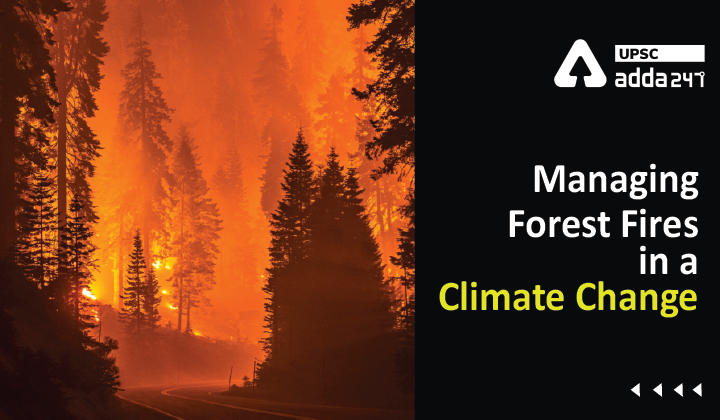Table of Contents
Forest fire UPSC: Relevance
- GS 3: Conservation, environmental pollution and degradation, environmental impact assessment.
Forest fire in India: Context
- In a recently conducted study, ‘Managing Forest Fires in a Changing Climate’, Council on Energy, Environment and Water (CEEW) found that forest fires have increased more than 10 times in the past two decades.
Managing Forest Fires in a Changing Climate: Key findings
- The study further highlighted that more than 62 per cent of Indian states are prone to high-intensity forest fires.
- CEEW found that Andhra Pradesh, Assam, Chhattisgarh, Odisha and Maharashtra are the states that are most prone to high-intensity forest fire events caused by rapid change in climate.
- The study also revealed that more than 75 per cent of Indian districts are extreme climate event hotspots, and more than 30 per cent of districts are extreme forest fire hotspots.
- Mizoram has had the highest number of forest fire incidences in the last two decades, with more than 95 per cent of its districts being forest fire hotspots.
- Tropical moist deciduous forests, followed by tropical dry deciduous forests, are most vulnerable to forest fires.
Reason of forest fires
There are three primary reasons of anthropogenic forest fires:
- Hot temperatures,
- Low humidity, and
- Increased dry spells
Increase in frequency of forest fire
- The recent incident at Sariska forest reserve was the fourth forest fire in the week when it occurred.
- Earlier, forest fires would take place during the summer months, that is between May and June. However, during spring, between March and May, we have started seeing many more forest fires due to climate change.
- This means the duration that forest fires could take place was two to three months earlier, but it is now nearly six months.
Forest fire in north east
- Most of the NER (northeastern region), including Arunachal Pradesh, Assam, Meghalaya, Mizoram, Nagaland, Manipur, and Tripura, barring Sikkim, are witnessing an increased frequency of forest fire incidences in recent decade.
- Despite the NER being a rain-fed area, it is witnessing more forest fire incidences during increased dry spells across March-May and due to the muddled rainfall distribution pattern.
Forest fire is a natural disaster
- Unlike cyclones, floods and earthquakes, which are big disasters, forest fires are not categorised as a natural disaster.
- This means that managing these fires fall under the purview of forest departments, which are understaffed and do not have the capacity to handle them.
- The study is of the view that by designating forest fires as natural disasters, there will also be a financial allotment made to manage them.
Managing Forest Fires in a Changing Climate: Recommendations
- The study recommended that forest fires should be treated as “natural disasters” and be brought under the National Disaster Management Authority.
- The study also recommended that forest fire alert systems should be developed for forest fires only, as opposed to detecting all kinds of fires, which distorts the data collected.
- At present, the moderate-resolution imaging spectroradiometer (MODIS) sensor is unable to distinguish a forest fire from crop burning, waste burning, and other smaller fires that may occur, which distorts the forest fire data.
- CEEW also recommended to improve the air quality monitoring in forest fire-prone areas, and increasing the adaptive capacity of forest departments and local communities to deal with an increase in fires.
Read current affairs for UPSC





 TSPSC Group 1 Question Paper 2024, Downl...
TSPSC Group 1 Question Paper 2024, Downl...
 TSPSC Group 1 Answer key 2024 Out, Downl...
TSPSC Group 1 Answer key 2024 Out, Downl...
 UPSC Prelims 2024 Question Paper, Downlo...
UPSC Prelims 2024 Question Paper, Downlo...




